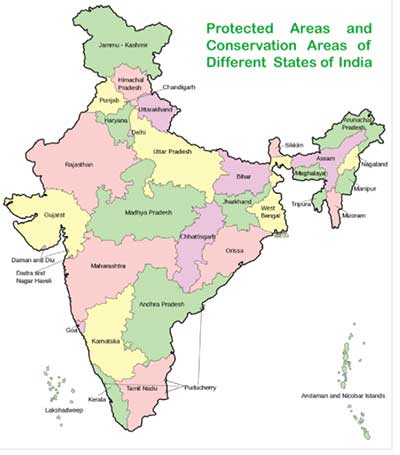Relevance: GS-3: Conservation, Environmental Pollution and Degradation, Environmental Impact Assessment
Key phrases: National Board of Wildlife, Vedanthangal, Important bird area
Why in news?
Tamil Nadu’s Controversial proposal to reduce core area of Vedanthangal Bird Sanctuary(India’s oldest bird habitat) dropped.
Analysis:
What are protected areas?
- Protected areas are regions or zones of land or sea which are given certain levels of protection for conservation of biodiversity and socio-environmental values with limited human intervention and exploitation of resources.
- There are several kinds of protected areas, which vary by level of protection. Examples include national parks, wildlife sanctuaries, marine protected areas, community reserves etc.
Status of protected areas in India
- With only 2.4% of the world’s land area, 16.7% of the world’s human population and 18% livestock, it contributes about 8% of the known global biodiversity
- India is home to world’s largest wild tiger population and has got unique assemblage of globally important endangered species like Asiatic lion, Asian Elephant, One horned Rhinoceros, Gangetic River Dolphin, Snow
Leopard, Kashmir Stag
- Network of 662 Protected Areas (PAs) has been established, extending over 1,58,508 sq. kms. (4.83% of total geographic area), comprising 104 National Parks, 551 Wildlife Sanctuaries, Conservation Reserves and Community Reserves.
Why is conservation required?
- Our varied ecosystem across land, rivers, oceans feed our people, enhance public health security and shield from environmental disasters
- Repairing our dysfunctional relationship with nature is one of the ways to mitigate climate change and curtail future outbreak of infectious diseases
- It can help rejuvenate agricultural production systems and increase rural incomes from biodiversity based agriculture while also creating millions of green jobs in restoration and nature tourism
- Global wildlife populations have fallen by 58% since 1970 and if the trend continues then two-thirds of wild animals may go extinct by 2020
- Estimates suggest that forest alone yield services worth more than a trillion rs per year
- A reservoir of wild animals and plants is preserved, thus enabling them to be introduced, if need be, in the surrounding areas.
- Conservation of essential ecological diversity to preserve the continuity of food chains.
India’s progress in conservation
- Enhanced Tree cover: India has enhanced the combined forest and tree cover to 24.56% of the total geographical area of the country
- Wildlife: India has the highest number of tigers in the wild and has doubled its numbers ahead of the deadline of 2022 and recently announced the launch of Project Lion and Project Dolphin
- Land restoration: India has announced that it aims to restore 26 million hectares of degraded and deforested land, and achieve land-degradation neutrality by 2030
Where are we lagging behind?
- Fluid boundaries of humans merging with forest with increasing population-only 25% of elephant population found in protected areas
- NBWL and forest advisory committees acting as rubber stamps-highways passing through critical stretches like tiger reserves-government’s recent plan to build highway named east west industrial corridor in core area of
Pakke tiger reserve
- Threat of invasive species-water hyacinth and Mimosa are great threats to Kaziranga
- Rangers lack modern weapons to tackle poachers armed with advanced - Kaziranga frequently in news die to this
Steps by Government
- Comprehensive Wildlife Protection Act of 1972 which provides protection to wildlife and gives framework for their in situ conservation
- National Board for Wildlife (NBWL) made it mandatory for every road/rail project proposal to include a wildlife passage plan as per guidelines framed by Wildlife Institute of India
- Special programmes like Project Elephant’ and ‘Project Tiger’ have been launched for conservation of these endangered species and their habitats.
Way ahead
- Remove encroachment on fringes of protected area by resort owners and landlords
- Expedite formation of State Tiger Protection Force
- Rope in locals for efficient and traditional conservation: Gujarat, a success story Maldharis of Gir- conservation of Amur Falcon in Nagaland
- Season wise biodiversity plans, flying squads and tactical patrolling: example Pench in MP
- Avoiding construction of highways, railways through reserves unless strictly unavoidable
- Building underpasses for wildlife wherever its unavoidable to construct a highway through reserve
Source: N Indian Express







